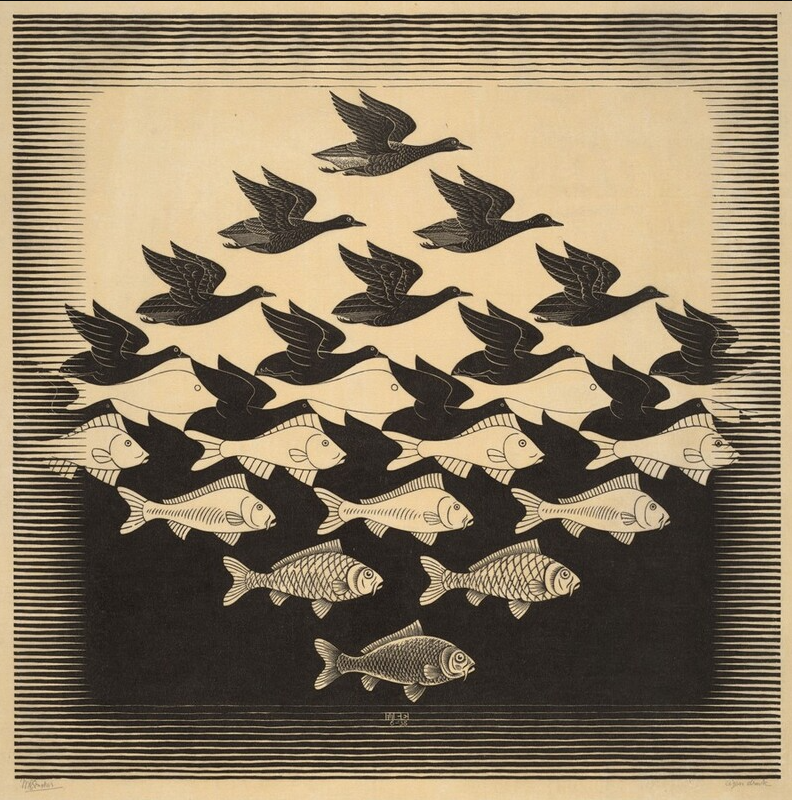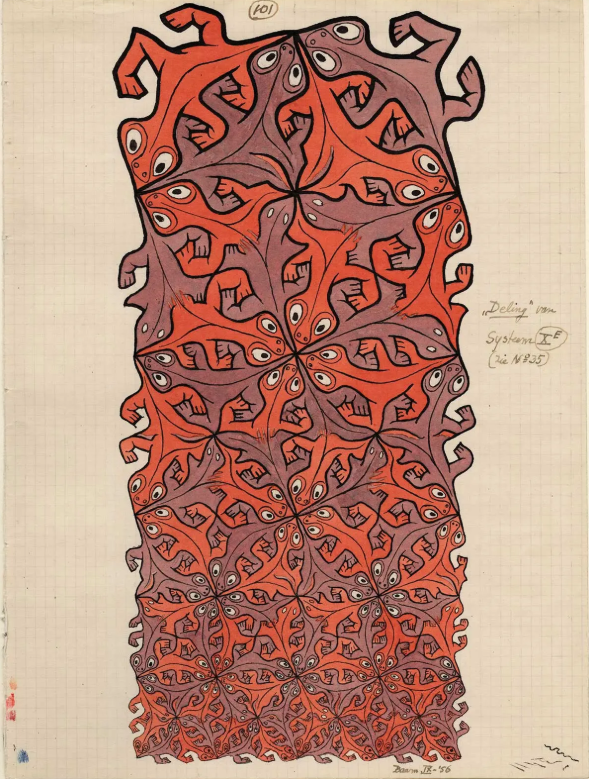Reptiles (M.C. Escher): from flat pattern to living creatures
Before continuing, please take a moment to really look at the work.
M.C. Escher’s Reptiles (1943) is one of his most playful and imaginative prints. At first glance it looks like a simple domestic scene: a desk littered with books, papers, and everyday objects. But at the center of the composition lies something impossible. A tessellation of lizards on a sheet of paper has come alive. The tiny reptiles climb out of the drawing, march across the real-world objects, and then crawl back into the paper as if nothing unusual had happened.
This work combines many of the themes that defined Escher’s career. It is about tessellation, certainly, but also about the fragile line between two and three dimensions, between imagination and reality. It is at once witty and deeply thoughtful, the kind of picture that makes you smile even as you sense something profound beneath its surface.
General Information About Reptiles
Escher created Reptiles as a lithograph in 1943, while living in Baarn, the Netherlands. By this point, tessellation was already central to his artistic practice; he had spent years experimenting with how shapes could interlock and transform. The lizard, with its flexible body and curved tail, was a natural fit for these designs and appeared often in his tessellation studies.
The print is relatively small in size, but packed with detail. On the desk, we see not only the tessellated paper but also a tin of pencils, a glass, a notebook, and even a dodecahedron, one of the Platonic solids that fascinated mathematicians and artists alike. By choosing ordinary household objects as the backdrop, Escher heightened the surrealism: the fantastical intrudes not in a dreamscape but in the middle of everyday life.
Today, Reptiles is considered one of Escher’s most famous works and is widely reproduced in books, posters, and exhibitions. Collectors prize original signed lithographs, which are relatively rare and often command high prices at auction.
Regular Division of the Plane with Lizards, 1939. Watercolour.
What Was M.C. Escher’s Most Famous Piece?
Escher created many images that could claim the title of “most famous”. Reptiles belongs in this top tier because of its broad appeal alongside Relativity with its impossible staircases, Drawing Hands with its recursive paradox, and Sky and Water I with its elegant tessellation of birds and fish. Unlike some of Escher’s more mathematically abstract works, it tells a story that anyone can immediately grasp: creatures crawl out of the flat page, march across everyday objects, and slip back into their two-dimensional cage. It blends humor with wonder, balancing the surreal with the familiar.
That clarity has made Reptiles unforgettable. It bridges audiences who might otherwise never meet: art lovers, mathematicians, philosophers, and casual viewers alike. The image captures Escher’s genius for collapsing the boundary between reality and imagination, and for making impossibility feel not just believable, but delightful.
Sky and Water I, 1938. Woodcut.
What Makes M.C. Escher’s Art Unique?
Escher’s art is unique because it bridges two worlds rarely connected: the rigor of mathematics and the imagination of fine art. He was not a trained mathematician, yet his instinct for symmetry, infinity, and geometric transformation was extraordinary. What could have been dry demonstrations of geometry became lively, witty, and often mysterious pictures.
In Reptiles, we see this uniqueness clearly. A flat tessellation alone might have been clever but uninspiring. By animating it, having the lizards crawl into the three-dimensional world, Escher made geometry playful and philosophical at once. He treated mathematical order not as an end in itself, but as a springboard for imagination.
Regular division drawing, 1956. Watercolour.
Conclusion
Reptiles remains one of M.C. Escher’s most engaging works because it is both simple and profound. On the surface, it is a humorous scene: lizards on a tabletop adventure. Beneath that humor lies a meditation on art itself, how flat images can conjure life, how imagination seeps into reality.
For collectors, the print is a prized piece, one of the clearest examples of Escher’s tessellation period. For casual viewers, it is simply delightful. And for anyone interested in the intersection of art and mathematics, Reptiles is a reminder of why Escher’s work is so endlessly fascinating.



